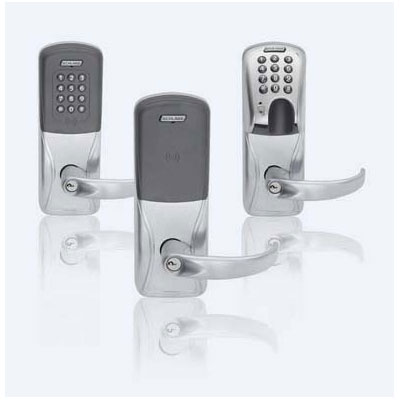Schlage AD Series Access Control Locks

The Versatile AD Series
Schlage AD series networked access control locks work with a wide variety of credentials and functionality and can be integrated with a wide range of access control systems.
Allegion has partnered with many popular access control software companies. With some access control companies, AD locks must be purchased through that access control company to avoid punitive licensing fees. There is a bonus in doing so, however, because programming and installation are simpler and usually less expensive in addition to avoiding those fees.
Models within the series are available in cylindrical, mortise and exit device trim versions, however, the exit trim versions only work on Von Duprin 98/99 and 22 series devices and Falcon 25 series exit devices (see below).

Hardwired or Wireless
There are two main branches of AD series locks: hardwired and wireless.
The hardwired AD-300 series can be added to wired access control systems via a Panel Interface Board.
The wireless AD-400 are connected wirelessly to the access control panel via a Panel Interface Module.
The AD-302 and AD-402 are the same as above, but are used only for installations for the United States federal government.
The wireless AD-400 versions are more popular since they require much less wiring.
Choose a Chassis, a Function and a Reader
Chassis choices:
- Cylindrical
- Mortise
- Mortise with deadbolt
- Exit trim
Function Choices:
- Privacy
- Office/classroom
- Apartment
- Storeroom
Storeroom function in an AD lock means always locked unless momentarily unlocked by a user. After the user enters, the lock re-locks itself.
Recruit a reader:
- Keypad
- Magnetic stripe (insertion)
- Magnetic stripe + keypad (insertion)
- Magnetic stripe (swipe)
- Magnetic stripe + keypad (swipe)
- Multi-technology (125 kHz, 13.56 MHz, NFC)
- Multi-technology + keypad (125 kHz, 13.56 MHz, NFC)
- FIPS 201-1 compliant multi-technology + keypad (125 kHz and 13.56 MHz)
- HID support
- HID support + keypad
- DT Dummy trim
Below is a graphic showing some of the available readers.

Lever Design, Finish, Key Cylinder and Keyway
Scroll down to see the lever designs.
Available finishes:
- Bright Brass
- Satin Brass
- Satin Bronze
- Satin Nickel
- Bright Chrome
- Satin Chrome
- Satin Chrome Antimicrobial
- Aged Bronze
Key Cylinder and Keyway
The standard keyway is Schlage S123, and the standard cylinder is fixed core key in lever. However, Schlage offers many key cylinder options compatible with several manufactuers interchangeable cores and fixed core cylinders.

Retrofit Considerations
Schlage Electronics replaced four existing product lines with the new AD series as of January 1st, 2011:
- The AD-200 series replaced the old CM series
- The AD-250 series replaced the old CL series
- The AD-300 series replaced the old VIP series
- The AD-400 series replaced the old WA series
The KC-2 King Cobra and MPC Cobra series locks were phased out by the end of December, 2010. In the fall of 2010 Schlage introduced the new CO series to replace the KC series and PRO series products.
In many instances the new AD series lock will not cover the old prep. To compensate, Schlage has provided decorative plates in Small, Medium and Large sizes to cover the leftover holes.
A second important retrofit consideration with the AD series vs. the CM, CL, and VIP series is that the AD series locks are key-in-lever whereas the CM, CL and VIP series (except the CM and CL 5200 series) required mortise cylinders. A site has a key system in place with mortise cylinders, for example, Medeco or KabaPeaks, the cylinders will need to be replaced as well as the lock.
However, if the existing system is a Schlage, Corbin, Yale, Sargent or Medeco full size interchangeable core, you are in luck because AD series locks are available in all of these interchangeable core preps. AD series locks are also available in small format interchangeable core prep (Best, Arrow, Falcon, KSP).
Another change in certain models is the location of the door position switch (DPS). On the AD series models, it appears that in most cases in which a DPS is required it is located about one inch lower than in the corresponding obsolete unit.
These issues are not insurmountable, but installers and estimators need to be aware of them to avoid installation and pricing problems.
© 2010 Tom rubenoff







